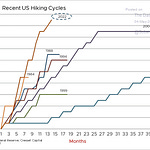NEXT WEEK I’m out of the country on a business trip so there will be no letters until the week after next.
To make up for it though I have a bumper issue today – starting with another excellent discussion with Joachim Klement from Liberum, this time on ESG investing.
Earlier in the week, we talked about investment truths, to which we largely ended up agreeing. This time we start by disagreeing but in the end, probably find ourselves in agreement – impact and sustainable investing have huge potential if we can somehow work our way past the whole ESG debate. It’s a fascinating discussion for just over 30 minutes – as with the earlier episode there’s a slight echo (entirely due to a technical snafu on my side) but it’s really minimal this time and very easy to listen to.
As for further reading for the weekend, I have an abundance of interesting pieces which is why there are no short factoids – we’d end up with a letter that was way too long if I did include them. So, to business….
The SJP Difference
I’ve somehow managed to avoid writing anything about St James Place (SJP) for two decades. To be honest I’ve never really had much time for their offer but I know many people who love the service levels. But it’s hard not to view their product set as more than a tad expensive, with initial charges of 5% plus annual charges for funds wrapper products mostly in the 1.5 to 2% range – though their Diversified Assets (FAIF) product has an annual charge of 2.42%. I’ve gone on the record in the past to suggest that the total cost of advice should never exceed 1% per annum while fund fees should never really be too much above 75 basis points.
The excellent Yodelar service has done a great deep dive into the SJP offering, with the following devastating conclusions:
· 80% of St James’s Place unit trust funds rated as poor performing
· High charges and poor performance across their entire range of funds
· 80% of SJP funds performed worse than half of same sector over 10 years.
· 15% of all St. James’s Place funds returned losses over 10 years
· 75% of SJP funds yielded returns below the sector average over 5 years
· St James’s Place initial fee more than twice the industry average
· £100 billion managed by St James’s Place is held in poor funds
· Restricted advice with no onus to provide comparative performance.
You can read more at Yodelar here: https://www.yodelar.com/insights/st-jamess-place-review?utm_medium=email&_hsmi=250481932&_hsenc=p2ANqtz--urBDyPhS61TygVT4FOMONoRp486-pQ7u43Z_z-ik61tIE0nzgCNjZKJwBFDl2B5J8S40PBGoMIF3C_o9T58l0FAkdh-8Spc38BrceDVx9HI6RQ0I&utm_content=250481932&utm_source=hs_email
Liberal girls are depressed
There’s a fascinating note from the social psychologist Jonathan Haidt called Why the Mental Health of Liberal Girls Sank First and Fastest. You can read it HERE. It’s a great paper and part of a wider debate around political affinities and mental health issues. Needless to say, its fairly controversial stuff but there’s a brilliant summary from the folks at The Progress Network of Haidt’s article:
“It’s his latest examination of the data showing that rates of anxiety and depression in young people spiked after 2012, which Haidt pins to the introduction of smartphones and social media. This new piece attempts to explain why, out of all Gen Z groups across gender and political affiliation, liberal girls are the most depressed, and were the first to become so ten years ago. “I think,” Haidt writes, “there’s something about the messages liberal girls consume that is more damaging to mental health” than those consumed by liberal boys, as well as moderate and conservative boys and girls.
Still, however, all of those groups are more anxious and depressed than in previous generations. Haidt posits that something in the cultural air—he calls out the “three great untruths” that words are violence; emotions are reliable guides to reality; and society is comprised of victims and oppressors—has done two things.
First, moved Gen Z’s locus of control from internal to external. This means that instead of feeling a sense of agency, like we are the captains of our own ships, someone with an external locus of control feels that “strong forces or agents outside of themselves will determine what happens to them.” Second, led to a sharp rise in self-derogatory beliefs like I feel I can’t do anything right and I do not have much to be proud of.
Haidt may be right or wrong that there is something in the zeitgeist, particularly in the liberal social media one, that is causing what he calls “reverse CBT.” Here he is referring to cognitive behavioral therapy, a common therapy technique that teaches how to rework thought patterns to stop “cognitive distortions” such as catastrophizing and black-and-white thinking. Instead, he says, Gen Z is learning to emphasize such cognitive distortions.
If Haidt’s theory is right, however, it suggests that we can reverse the "reverse CBT" by finding strategies for rewriting the “captain of your own ship” narrative for Gen Z and subsequent generations. “
More at
Crime: throw away the keys?
Crime is turning into a central issue in the US political debate, with attention focused on Washington DC – which is undergoing something of a crimewave at the moment which has prompted various legislative moves in Congress.
One can of course be slightly cynical about this – Republicans bashing inner-city Democrats, linking up the immigration debate to create wedge culture war issues. But I think that is a fatal misreading of the situation.
Throughout much of the developed world from Sweden to the UK crime is becoming a hot topic – and astute political parties pick up on the general sense of unease. The Labour Party in the UK for instance, I think, has sensibly avoided all the defund the police nonsense and explicitly committed itself to more police, more crime busting and critically attacking the sources of community-wide anger: low-level street violence, burglary, and low-level fraud. This is a winning strategy in my book – for too long we in the metropolitan liberal classes have said that crime is falling, that prisons should be emptied out at all costs, that prison doesn’t work, and that we should stop worrying about crime and focus on correcting inequality. Turns out that that doesn’t wash with most people.
As a magistrate with many decades of experience, I accept that we should be putting fewer people in prison and I also think that convicting lots of young people leaves them saddled with a long-term criminal record which is a terrible state of affairs. But I also think that locking up persistent violent offenders for longer periods of time, largely to keep them off our streets makes sense. Sure we all need to care about the human rights of criminals but the human rights of victims are not served by letting persistent offenders out on the street to, in some cases, terrorize local communities. For too long we’ve failed in that balancing act and the public knows it.
A wonderful example of this comes in the graphic below from the blog of Scott Alexander who cites a tweet showing British attitudes toward crime….the numbers are truly amazing and include the following…
“…….about 15% who want prison time for not wearing a seatbelt, 47% who want prison time for sexist abuse on social media, and 80% who want prison time for possession of a knife (and 18% think it should be over five years)! Meanwhile, in actual Britain, a guy with multiple previous violence convictions who brutally assaulted a cyclist and then stomped on her head while she lay unconscious was let off with community service. This is an interesting contrast to see in a democracy!”
The graphic below is absolutely amazing. Of course many people have long favored hanging killers but the numbers below are fascinating.


This segways into an interesting debate about how far we go to provide a hostile environment to criminals to stop them from doing stuff we don’t want to do. In the US for instance the liberal American Purpose publication has an excellent article about revisiting James Wilson’s broken windows theory which I think might make a phoenix like re-emergence within the public debate.
Another example is the ongoing debate around the horrific murder rate in El Salvador which has fallen back sharply in recent years because of an especially brutal/effective set of policies by its leader Bukele. On one side is the classic liberal point of view admirably expressed by the FT in a recent investigation into a huge new prison being planned - which to be fair does sound pretty horrific and like something out of a dystopian sci fi film:
“ If it reaches the 40,000 capacity advertised by the government, each inmate will have just 0.6 square metres within shared cells, according to FT calculations. That is a fraction of what is expected for humane incarceration and less than half the minimum required under EU law to transport midsized cattle by road. “Forty thousand is too many to manage in one place, period. Under any circumstances,” said Martin Horn, a retired administrator who ran New York City’s prisons, including Rikers Island, one of the world’s largest.”
Yet Bukele is hugely popular in El Salvador because of the stunning recent decline in the murder rate. Hobbes might have had a few things to say about the conflict between the human rights of criminals and the need for the state to guarantee the basic human rights of citizens not to be in fear of the ‘jungle’ and getting murdered. The commentator Richard Hanania – a conservative of sorts – is especially vocal about Bukele and his ‘success’.
“The year before Bukele came into office, El Salvador had a murder rate of 51 per 100,000, making the entire country about as violent as modern Detroit, which is such a basketcase that you can take a virtual tour of the ruins of the city or see them in a coffee table book. El Salvador was growing at about 2% a year before 2019, which is terrible for a developing country, and a quarter of its GDP comes from remittances from the US, which is one of the highest numbers in the world. But, since the gang crackdown, The Washington Post reports that, the real sea change is on the ground, where citizens report that extortion has all but disappeared. Salvadorans have gained a palpable sense of security in their everyday lives at the expense of due process, democracy and transparency. Most seem to be fine with the trade-off. Bukele himself is immensely popular, as is the state of emergency he has declared. Protests against him have fizzled.
Ideally, you’d like to be able to fight crime while also protecting human rights and not creating opportunities for the arbitrary abuse of government power. In the real world, this is usually asking too much of governments in developing countries. Previous Salvadoran governments have tried more limited crackdowns before with limited success. Just look at how much trouble the US has had keeping inner-city dysfunction under control since the Warren Court started creating new rights for criminals in the 1960s. Now imagine trying to accomplish the same with a government that is orders of magnitude poorer and starting out with the entire country being as violent as Detroit.”
More at
And a follow-up as the debate kicked off :
Indoor Farming melts down
As a verified food tech evangelist – do visit my sister website www.futurefoodfinance.com – I have wasted many column inches singing the praises of indoor and vertical farming. The idea here is to build a closed-loop system, mainly in urban areas (though not exclusively) where you only need water and lots of LED lighting to produce fresh greens and some fruit. On paper, it sounds like the future as it radically cuts pollution and emissions although it also requires a huge capital expenditure on state-of-the-art urban farms.
The slight catch is that it doesn’t seem to be working as well as we evangelists might have hoped. One industry publication a few weeks ago carried the following story about the share prices of listed indoor farmers : “AppHarvest saw a decline of 25.71%, while Local Bounti lost 17.21%, Kalera PLC lost 7.50%, Urban-gro lost 4.19%, HydroFarm lost 4.91%, CEA Industries lost 3.17%, and Agrify Corp lost 9.61%. On the other hand, Edible Garden Ag made gains of 11.59%.” Yikes.
And those numbers are just for one week in March! Every month brings more bad news as operators in this space close down – the latest is Fifth Season featured in a piece by the Fast Company managzine.
“AppHarvest, which runs high-tech greenhouses in Appalachia growing tomatoes and greens, said in a recent quarterly report that it had “substantial doubt about our ability to continue as a going concern” unless it could raise more money; the company is currently being sued by investors who argue that it misled them about its viability. AeroFarms, an early pioneer in the space, pulled out of a proposed SPAC deal last year. In the company’s May 2021 investor presentation, AeroFarms, which was founded in 2004, estimated just $4 million in 2021 EBITDA-adjusted revenue—and $39 million in losses.”
Its tough out there! More about the vertical farm meltdown here: https://www.fastcompany.com/90824702/vertical-farming-failing-profitable-appharvest-aerofarms-bowery
Winning Wars
Now that we’re all armchair military experts because of the Ukraine conflict, I suppose we should up our game and actually learn about how wars are won – especially the high-intensity war currently being fought in the East (low-intensity wars are more typical of the post 9/11 environment).
I thoroughly recommend an excellent overview by Austin Vernon – I have no idea if he’s an expert or not but he sounds convincing. Here are several useful strategies for fighting an existential war:
Cheap Precision
In total war, boutique weapons won't be able to destroy enough enemies even if they are tactically successful. It is also challenging to produce and transport the mind-boggling mass inaccurate weapons require. The sweet spot is accurate but cheap weapons. These can be classic smart weapons like GPS-gravity bombs but also include an Abrams tank that can reliably kill adversaries 3000 meters away with unguided shells.
Avoid Unreliable Systems
An enemy can grind unreliable weapons into the ground by forcing a high tempo. The twenty US B-2 Bombers could deliver a one-time nuclear strike but could not eliminate thousands of Chinese ships, bases, and troop concentrations because of their low sortie rate and limited numbers.
Manage Survivability vs. Expendability Carefully
There are many tradeoffs when designing weapons. The math tends to push design choices towards cheap, less survivable systems or pricier, long-lasting ones. Survivability can come from the ability to take damage (like having armor) or from deception (stealth, electronic interference, speed).
The cheap system could lack the capability to score any kill against superior weapons or end up still being too expensive. The expensive one could be more vulnerable or less effective than hoped. What capabilities a country has and its strategic position matter when choosing.
A classic comparison is the US Sherman tank and the Soviet T-34 in World War II. The Soviets saw that tanks on the Eastern front rarely lasted 24 hours in battle and took planned obsolescence to the extreme to make the T-34 cheap. The US designed the Sherman for reliability and repairability. Engineers carefully designed engines and suspensions for durability. The number of Shermans in Europe kept increasing because mechanics would have "knocked out" tanks back in battle within days.
Focus on Mass Production
An adversary can make a powerful weapon irrelevant by sheer numbers if it is challenging to produce. Historical examples include the Tiger Tank, Me-262, and sophisticated cruise missiles.
The need for easy-to-manufacture designs is even more critical for expendable munitions. Neither Russia nor Ukraine have top ten economies, yet they are drawing down global munition stocks. Each side must carefully manage consumption and substitute away from bespoke weapons like Javelin missiles for more available systems. Imagine the top two economies duking it out.
The enemy can often fight harder than you think and regenerate more forces than you hope. The conflict can rapidly devolve into a lower-tech slugfest with alarming casualty counts if you can't produce enough capable weapons.
Have Appropriate Designs Ready
The US won World War II by increasing the output of weapons already in production or well into development. It took too long to bring new designs into mass production. And it was much easier to expand the output of systems already in production than ramp up programs coming out of development. The several-year penalty for new designs could cost millions of lives or the war.
I also thought this next section was revealing – the importance of industrial power:
Ammunition will be the most voracious microchip user. There are only so many chip types in a JDAM or GMLRS rocket. The military should buy capacity options for the chips we know we will need instead of subsidizing the broad industry, which may or may not produce viable chips for military applications. That capacity can provide starvation rations while chip manufacturing capacity expands by several orders of magnitude.
Traditionally the military takes over commercial ships for transport in wartime, and we protect the shipbuilding industry to "maintain capacity." There are a few deficiencies in that plan:
Commercial ships now dwarf military shipping. How helpful is a 25,000 TEU container ship or a Very Large Crude Carrier that can only use a few dozen ports globally? The military will need floating harbors to handle transfers from large ships to smaller sustainment vessels that deliver supplies to the Navy, Air Force, and Marines. Another issue is that most military cargo moves on pallets rather than inside containers. All services must speed up containerizing logistics and eliminate remaining break bulk and pallet shipping. The ability to move supplies and fuel from safe ports in the US without using fixed transshipment facilities would provide a survivable logistics chain.
There is a shortage of US-flagged ships to take over because of the Jones Act and labor regulations. There are ~5x-10x more American-owned ships that fly the flag of other countries to avoid the rules. Make it easier for these ships to fly the US flag!
Shipyard productivity is awful because of a lack of scale and competition. We'd be better off ending the Jones Act and buying more ships if we want more capacity. More manufacturable ships will increase dollars spent in shipyards by expending less on overhead or expensive systems vulnerable to combat damage. Also, few have grappled with the reality that all combatants have a minuscule fraction of the shipbuilding capacity ultimately required for total war. Even if China builds more ships today, the amount added by both sides will be similar since everyone is effectively starting from zero.
You can read much, much more at https://austinvernon.site/blog/peerwareconomics.html?ref=the-browser
Whilst on the subject of war I also thoroughly recommend a fascinating interview with a couple of Ukrainian artillery commanders about the war in the East.
(I): How realistic is it to hit a moving target?
(O): For a firing battery, there is no difference, but artillery luck also works here. If you calculated everything correctly – the enemy’s speed of movement, the flight time of the shell – then the result will be fire, sparks, and smoke. That is, it is what it should be.
(I): So you managed to hit a moving column the first time?
(Serhiy): Not always. That’s why we needed “eyes”. We also called civilians and asked: “Do you see this section of the road?” “I do.” “If a shell hits in a minute and a half, can you tell us at least roughly where it exploded?” “I can. Then the person would describe the place of the explosion, and we would open a Google map and see: yes, there is such a place behind the vegetable gardens.
(O): We had an 18-year-old boy in Motyzhyn whom we reached through the store’s phone number on Google map and said: “I don’t believe you.” So we turned on the video link, showed him our ID, uniform, and chevron, and he said: “I don’t believe you”.
Then we convinced him and worked closely together for about half a month while fighting in Motyzhyn. And every local in the village knows someone else, and that person knows someone else, so there are already people passing on information. So at first, I called from my number, and then we got a separate phone, and then it was not enough, so we got a second one.
Sometime in the fall, I called this guy from Motyzhyn and said: “Come, let’s get acquainted.”
The full interview is here:
https://wartranslated.com/pravda-com-ua-interview-ukrainian-colonel-oleh-shevchuk/?ref=the-browser
And finally, on the subject of war let’s turn to Mexico. It is supposedly a close friend of the USA but it is also home to some extremely powerful, militarised crime gangs that the Mexican state is struggling to contain. So, let’s put two and two together and come up with…5. And attack Mexico. That at least is the idea behind a bill called Authorization for the use of Military Force (AUMF) which aims to target the cartels and put an end to the flow of fentanyl into the U.S, sponsored by Reps. Dan Crenshaw of Texas and Mike Waltz of Florida.
“First, the proposed AUMF lists nine specific cartels across Mexico and Central America and authorizes the president to “use all necessary and appropriate force” against them:
The Sinaloa Cartel.
The Jalisco New Generation Cartel.
The Gulf Cartel.
The Los Zetas Cartel.
The Northeast Cartel.
The Juarez Cartel.
The Tijuana Cartel.
The Beltran-Levya Cartel.
The La Familia Michoacana, also known as the Knight Templar Cartel.
But the bill would not provide a free-for-all license to attack these organizations at the whim of an Army commander near the border or the captain of a Tomahawk-equipped destroyer traversing the Gulf of Mexico. “It becomes just an authorization to actually create a strategy,” Crenshaw says. “We don’t create the strategy necessarily. That’s the president's job. So it’s just the first step.”
The authors say they took as a model the United States’ approach to tackling the drug cartels in Colombia in the 1980s and ’90s, which Crenshaw said worked “because we had a strong partner in the Colombian government. This is what we’ve been lacking in Mexico.” In Mexico’s case, by contrast, the cartels are embedded in many areas of government.
“And so in Mexico, I think you’ve got to leverage [the Mexican government] more. I think that’s one of the reasons AUMF is useful. Because it lets them know we’re serious,” Crenshaw said. “The problem with this Mexican president [Andrés Manuel López Obrador] is he doesn’t apparently want to solve the problem.” So the AUMF approach puts pressure on López Obrador to act, in hopes of something more like a Colombia-style collaboration with the United States.
The bill’s other author, Mike Waltz, was even less charitable toward Mexico, to put it lightly. He told me, “We have essentially an ungoverned narcoterrorist state directly on our border, and I would posture that if ISIS or Al Qaeda sent chemical weapons that killed 80,000 Americans, we would probably be thinking about it and doing something about it.”
More at
Eloi vs Morlocks
As a sci-fi freak, I of course read HG Wells's Time Machine at an early age and became slightly obsessed with the way that the human race had divided into two distinct races the Eloi and the Morlocks.
This idea of the bifurcation of the human race is a common trope for sci-fi authors – Richard Morgan in Altered Carbon in effect posits the idea that a genetic elite of wealthy types has evolved slightly differently from the rest of us.
Most readers would think this is all absurd fiction but I think it’s a very real fear. Combine genetic advances alongside better nutrition, more effective medications, and weight loss treatments and you have the making of a genetic divide – the rich who can access all kinds of tech-enabled services and the rest of us.
Step one is already here – the rich are frequently thin and in good physical shape. They also seem to be taking lots of Ozempic the so-called new anti-fat wonder drug. Put simply they ‘look different’.
US-based journalist Oliver Bateman on UnHerd – a self-confessed hard-core fitness dude – has a great piece about the super-rich and these new drugs.
“In short, this appears to be yet another sign that the elite are headed toward some sort of crude transhumanist utopia, complete with gene therapy and designer-baby selection. Some may scoff that this is science fiction, but this future looms: once they’re sufficiently fine-tuned, gene editing tools will likely eradicate heart disease, muscle wasting, neurodegenerative disorders, and other conditions in embryos that are still in utero — but their price will be nothing short of staggering. Similarly expensive gene therapies will enhance the overall performance of already-healthy humans, raising ethical questions about whether these procedures should “improve” a person or merely “fix” a condition. The rich, of course, will leave those debates to the philosophers and pay upfront for the best bodies that their considerable resources can buy. Already, news stories abound of billionaires pursuing immortality, with a few commentators trying to sanitise the pursuit by arguing that the research will somehow benefit even the least of us.
I have first-hand experience in the big-bucks world of anti-ageing science, and I can state unequivocally that the most compelling benefits are not going to trickle down. In 2017, I worked for a transhumanist medical organisation, producing marketing content related to stem-cell therapy and other forms of anti-ageing medicine. I received several treatments myself, and while I can only speak anecdotally, they significantly relieved decades of aches and pains related to hard training. And these were one-off procedures, not the monthly “Cadillac plan”, which involved steroids, growth hormones, and Botox. Wealthy clients would walk in as untrained, middle-aged slobs and, less than a year later, boast gym-hardened physiques that might take unenhanced trainees a decade to develop.
More at https://unherd.com/?p=464794
China is a peaceful nation and has no intention of getting involved in other nations’ polities
The thing I find so annoying about the Chinese government and its solemn declarations about nonintervention and pushing back on human rights challenges is that it’s a bare-faced lie. And the spokespeople know it. The Chinese regularly interfere in other countries, helpfully for instance sending police units to small pacific island states to curb ‘crime’. And the various Chinese front organizations regularly interfere in domestic politics. Take Canada for instance where the Chinese government has very clearly been sticking its oar into the local political process and interfering with the local conservative party:
“[Erin] O’Toole’s Conservatives came to voters in 2021 with an extensive position that called for a 180-degree turn away from the Trudeau government’s China-centric policies. Among other things, O’Toole’s policy called for restraints on Chinese state-owned enterprises in Canada, a ban on Huawei from Canada’s core 5G infrastructure, closer relations with Taiwan and the establishment of a foreign-influence registry.
Beijing was furious. Chinese ambassador Cong Peiwu blasted O’Toole for adopting a “hostile” blueprint that was aimed at “smearing” China. The Chinese Communist Party’s propaganda organs referred to O’Toole’s policy as catering to a “toxic atmosphere” that would surely invite a “strong counterstrike.”
These same lines of attack were taken up by Joe Li, a councillor in Markham, Ontario and spokesman for the Chinese Canadian Conservative Association who maintains close relations with several prominent figures affiliated with the United Front Work Department, Beijing’s overseas influence-peddling operation. In the days after the Conservatives’ election loss, the knives came out.
Speaking on behalf of the CCCA, Li said the Conservative policy under O’Toole was a “hatred message.” Li said Canada should not criticize China’s human rights record, that “Canada started the war” that led to the Michaels’ abduction by apprehending Huawei heiress Meng Wanzhou, and that China was right to be sending warplanes into Taiwan’s air-defence zone.
While O’Toole’s ouster was seen mostly as a rebuke from the party’s right flank for moving too close to the centre and losing the election in the bargain, the coup was initiated by Bert Chen, an Ontario member of the party’s national council. One of Chen’s complaints was O’Toole’s China policy. But well before O’Toole’s election to lead the Conservatives in 2020, wealthy Chinese businesspeople were suddenly showing up among the Conservative party’s donors and membership rolls.
One recent immigrant who stands out is Ted Jiancheng Zhou, a property developer with condominium projects in Ontario and China. Zhou, who boasts intimate connections in China’s Communist Party hierarchy, was among the hundreds of super-rich Chinese who maxed out their legal contributions to the Liberal party during Trudeau’s “cash for access” engagements with pro-Beijing Chinese millionaires in 2016.
But then he appeared to switch. Although he wasn’t yet a citizen and had been in Canada less than five years, Zhou established ten separate organizations across Canada devoted to drawing Chinese-Canadians into the Conservative party. The NDP and the Liberals asked federal Election Commissioner Yves Côté to look into whether Zhou’s activities were in violation of election spending laws, but the complaint went nowhere.”
More at















Share this post